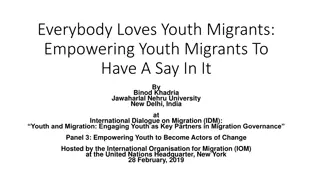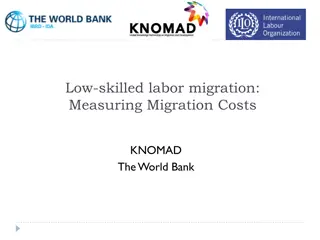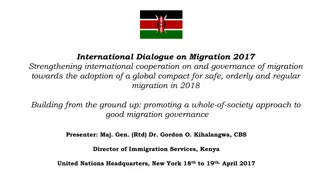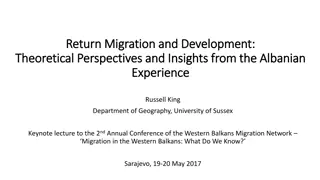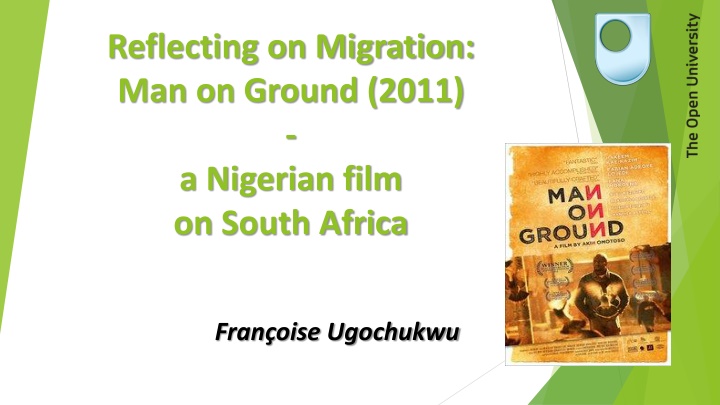
Exploring Nigerian Migration in South Africa Through the Film 'Man on Ground'
Delve into the complexities of Nigerian migration to South Africa through the lens of the film 'Man on Ground', directed by Akin Omotoso. This article analyzes the portrayal of intercultural communication, diplomatic challenges, and the impact of migration issues depicted in the movie. Discover how this narrative serves as a cautionary tale for potential immigrants.
Download Presentation

Please find below an Image/Link to download the presentation.
The content on the website is provided AS IS for your information and personal use only. It may not be sold, licensed, or shared on other websites without obtaining consent from the author. If you encounter any issues during the download, it is possible that the publisher has removed the file from their server.
You are allowed to download the files provided on this website for personal or commercial use, subject to the condition that they are used lawfully. All files are the property of their respective owners.
The content on the website is provided AS IS for your information and personal use only. It may not be sold, licensed, or shared on other websites without obtaining consent from the author.
E N D
Presentation Transcript
Reflecting on Migration: Man on Ground (2011) - a Nigerian film on South Africa Fran oise Ugochukwu
Southern Nigeria, a heavily populated territory, has experienced emigration since the colonial days. These migrations first took people to Britain or the United States for historical reasons. The first Nollywood films, Nigeria-made, recorded this trend, exploring widespread belief that Europe and America were better placed to ensure the happiness and prosperity of Nigerians who could make it there. The recession experienced by Nigeria in the early 1980s and the gradual tightening of immigration by Western countries within the last forty years changed the landscape, with more and more people exploring the rest of the African continent in search of a new elusive Eldorado. This paper considers the film Man on Ground (2011) produced and directed by the Nigeria-born South African Akin Omotoso in the context of problems encountered by Nigerian migrants in South Africa the growing diplomatic malaise affecting bilateral relations between Nigeria and South Africa, to study its reading of Nigerian immigration to South Africa.
THE FILM Man on Ground South Africa 2011. Director: Akin Omotoso Akin Omotoso, Kazeem Kae-Kazim, Rosie Motene et Fabian Adeoye Producer: Akin Omotoso Cast: Hakeem Kae-Kazim, Fabian Adeoye Lojede, Fana Mokoena, Buku Mazibuko, Thishiwe Ziqubu, Makhaola Ndebele Languages: English, Zulu, Sotho & Yoruba Colour, Blu-ray Disc, in English, Yoruba, Sotho, and Zulu with English subtitles. 80 mins.
SOURCE The film is directly inspired from events wich took place in the evening of Sunday 11th May 2008, when a gang of youths from the black suburb of Alexandra in Johannesburg invaded a house in London street and attacked its foreign residents, murdering them in cold blood and taking their properties. Within days, the violence later spread to the townships of Diepsloot and East Rand, where Ernesto Nhamuavhe, a Mozambican immigrant living in an informal settlement outside Johannesburg, was burned alive as onlookers laughed. Known internationally as the man on fire , Ernesto Nhamuavhe, who was married with children, inspired the film Man on Ground . http://www.nairaland.com/745001/nigerian-directed-film-man-ground
SYNOPSIS Director Akin Omotoso structures this intensely personal narrative as a thriller. Ade (Hakeem Kae-Kazim), a Nigerian banker living in London, desperately searches for his missing brother amid the xenophobic tensions of South Africa's townships. FOCUS The focus here will be on the film treatment of Nigerian and African migration in South Africa, on its interpretation of the current malaise between the two countries and on its audiovisual presentation of intercultural communication or the lack of it. The presentation ends with a consideration of the political and educational use of the film and its impact, in the line of traditional Nollywood films. It equally aims to show that in spite of its originality, this film closely follows the Nollywood edutainment model, seeking, in this case, to warn would-be immigrants against dangers waiting for them abroad.











